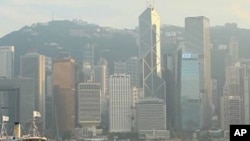Asia’s dramatic economic growth in recent years has come with environmental costs that can take a heavy toll on people’s health. While air pollution from busy factories and congested highways are part of the problem, there are also concerns about air quality in rural areas.
Like many big cities in Asia, a blanket of smog covers Hong Kong, causing cardiovascular and respiratory illnesses.
“...Air pollution in Asia is much more serious than anywhere else because of the economic growth and a lot of air pollution are produced in Asia....," said Professor CM Wong, of Hong Kong University’s School of Public Health. He says he has found a close correlation between air pollution and death rates in China’s industrial hub - Wuhan, Hong Kong and Shanghai - as well as in Thailand’s capital Bangkok.
“…Our findings were consistent among the four cities,” he said.
In Hong Kong, the bad air is even starting to affect the city's reputation as an international financial hub. Businesses in the financial sector say it has become harder to attract talent from other countries because of the air quality.
Half of the territory’s dirty air comes from urban transport like buses and ferries that emit nitrogen dioxide - a pollutant that scientists say can trigger complications in children with asthma.
The World Health Organization estimates safe levels of nitrogen dioxide, or NO2, should not exceed a yearly average of 40 micrograms per cubic meter.
“We can show that in one day the NO2 level can be 130, 140 something,” Professor Wong said.
Hong Kong University researcher TQ Thach has studied nitrogen dioxide levels for 11 years. His findings show a correlation between decreased visibility and higher death rates.
“From what I can see here, [visibility] is not more than five kilometers," he said. "We found that for every 6.5 kilometers decrease in visibility there’s an increase of 1.13 percent in deaths."
In the 1990s, Hong Kong managed to improve its air quality by tightening limits on sulfur dioxide, a potent compound that leads to higher childhood respiratory diseases and deaths among the elderly.
Carlson Chan is in charge of air quality policy at Hong Kong’s Environmental Protection Department. He says companies found ways around the stricter limits.
“When we tightened the sulfur content of industrial diesel from 0.5 percent to 0.005 percent in 1998, the resistance then was not very big, mainly because many manufacturers have moved their factories across the border,” he said.
Just across Hong Kong’s border is Guangdong province, the center of China’s export industry. As the factories there multiplied, the air pollution returned to Hong Kong.
But, the problems are not only confined to Asia’s cities.
In Northern Thailand, smog from burning trees blankets the mountains - especially during the dry season, when farmers are planting their crops.
An upland farmer defends this traditional method of clearing his field for planting. He says if it were a forest fire, it would have an impact on air pollution. But, he says, he only burns a little.
However, Chiang Mai University Professor Tippawan Prapamontol and her team found high levels of a pollutant called policyclic aromatic hydrocarbons or PAH among mountain residents. Their levels were even higher than those of city dwellers.
“In the urban area in this province…it’s just about this," she said using a pencil to demonstrate the scale of how rural people are exposed to much more than urban populations. "But in rural area it’s about this much.”
PAH is a compound that is found in vehicle exhaust and asphalt processing, as well as burning plants and garbage. The U.S. Environmental Protection Authority says severe exposure to PAH can suppress a person’s immune system.
“It’s very hard to tell the people that look you don’t have any problem now but you will have it in the future,” Professor Tippawan Prapamontol said.
Experts have called on governments for a more stringent policy to improve air quality. But even if authorities follow the WHO pollution level targets in cities like Hong Kong, it will take decades to bring back the air to safer levels.












